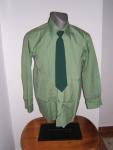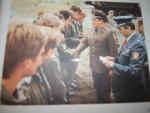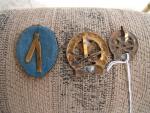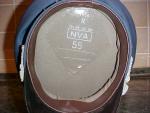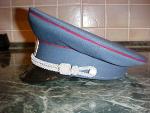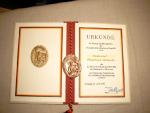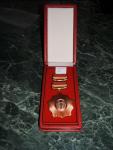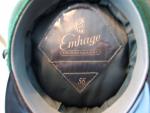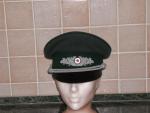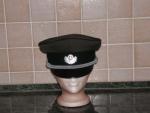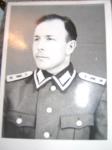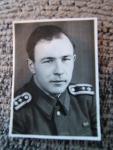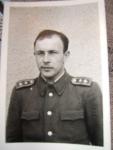-
Posts
4,807 -
Joined
-
Last visited
-
Days Won
12
Content Type
Profiles
Forums
Blogs
Gallery
Events
Store
Everything posted by Gordon Craig
-

DDR East German Forestry Service Uniforms
Gordon Craig replied to Gordon Craig's topic in Germany: Post 1945: Bundesrepublik & DDR
Next is the standard State Forestry tunic. It has four pockets closed with green plastic buttons. The upper breast pockets are false pockets with just the flap. The front closure has four plastic buttons. The shoulderboards are for the rank of Forst Anwarter. A forestry member who has just joined and is on a probationary period. I beleive this is a later period uniform as it is made of a more modern material instead of wool. -

DDR East German Forestry Service Uniforms
Gordon Craig replied to Gordon Craig's topic in Germany: Post 1945: Bundesrepublik & DDR
Time to add some state forestry uniforms to this thread. First is a long sleeved shirt for winter wear. Note the green colour which is different from that of the DDR police. This shirt would have been worn with the jacket because there is no way to attach shoulderboards to indicate rank. There is not makers mark in the shirt. Just a size 41N tag at the neck. The tie shown with the shirt is a police tie which I have been told is what was done. Since DDR ties were not notmally marked it is hard to say if there was a specific green State Forestry tie as there was with the NVA Forestry Service uniform. -

Hungary True 1956 Revolution Tunic
Gordon Craig replied to hunyadi's topic in Central & Eastern European States
Ulsterman, Which Osprey book are you refering to? Regards, Gordon -

DDR The GST Land Peaked Cap
Gordon Craig replied to Gordon Craig's topic in Germany: Post 1945: Bundesrepublik & DDR
Dan, Here is a picture of a GST functionary in his full blue uniform duringa GST award ceremony. Note the red tie worn by the full time GST functionaries. Also, you can just see the slip on rank tabs (tabs isn't exactly the correct word but I can not think of the right one at this instant) on his shoulder tabs. Regards, Gordon -
Charles, Sorry. I should have shown both sides of the cap badges. The large and small cap badges are both new and have one prong broken off the rear so the front photo is somewhat decieving. For those others who read the post, and to remove ambiguity, here is a picture of the back of both the large and the small cap badge next to the back of a Combat Officers badge. The cap badges prongs are clearly pointed and meant to be pushed through a cap and bent over whereas the round ended prongs of the Combat badge are not meant to be bent but to simply slip into the thread loops of the tunic. OOPS Forgot the picture. Here it is now. Regards, Gordon
-

DDR My DDR Police Collection
Gordon Craig replied to Hauptmann's topic in Germany: Post 1945: Bundesrepublik & DDR
Dan, Paul, Thanks for the comments on the grouping. Small but interesting. I have to thank my comments in Germany for some of the things like that in my collection. Over the years I've added a number of groupings which unfortunately I can not post because they re all in storage. Congrats on getting the medal Dan. Nice to have a medal and an Urkunde to go together. Looks as though it has been around a bit though. Don't be surprised if it is a little less appealing when you receive it than in the photo. Pictures always make an item look to be in better condition than they really are. I'm not trying to throw cold water on your enthusiasm, just trying to be realistic. You probably already know this but I'll say it again anyway. Don't try and clean the medal, the ribbon or the case. They look the way they because of age and each piece has its own characteristics that make it unique. When I receice something in the mail and it look worse than what I expected I often feel disappointed by this feeling soon passes and I begin to appreciate the piece for what it is. There was only one instance where I was disappointed enough to email the vendor and express my dissatisfaction and that was on a WWII tunic belonging to an Italian General of the University Troops that really was in much worse condition than expected. Especially for the price I padi. But even here, in retrospect, I like this tunic becuase of just what it is. Besides, I have never seen another at any price! Regards, Gordon -

DDR The GST Land Peaked Cap
Gordon Craig replied to Gordon Craig's topic in Germany: Post 1945: Bundesrepublik & DDR
Dan, The blue uniform worn with this cap is the same cut as the NVA uniforms but the same colour as the cap. They are also not too common. I wanted to post a picture of one in wear but I don't have a copy on my hard drive only on a floppy and my floppy drive died last week. I'll try and find another picture to post by the weekend. The GST Air caps are really hard to find. There is a specific cap for women in the GST who were full time GST funcrionaries and packed parachutes. Obviously a small group. It is the standard NVA woman's winter cap but in the GST blue with the GST Air insignia on the front. I bought one about a year and a half ago and when it arrived it was a fake. Very disappointing. Regards, Gordon -
Ulsterman, Both of the badges I posted appear to be cap badges. Charles says he has seen a pocket badge such as he pictured with the normal double prongs on the back. Correct Charles? T Thatns for the photo. It is a beaut of the badge in wear. I need to add one of those to go with my two cap badges. The breast badge could be worn on an early police uniform but where do I find one of those? Regards, Gordon
-

DDR The GST Land Peaked Cap
Gordon Craig replied to Gordon Craig's topic in Germany: Post 1945: Bundesrepublik & DDR
-

DDR The GST Land Peaked Cap
Gordon Craig replied to Gordon Craig's topic in Germany: Post 1945: Bundesrepublik & DDR
-
This post concernes a GST Land peaked cap. This is an item I picked up on a WAF DDR Forum ?meeting? in Berlin in 2006. Before I start on the cap, lets have a brief bit of history on the GST. The Geselschaft f?r Sport und Tecknik (GST) came into being in 1952 and its main task was to ?promote the general military readiness and fitness and to prepare all youth adequately before they enter military service and to provide special advanced training for the military service?. The base for the GST had been formed previously in the Frei Deutsche Jugend (FDJ) and developed in the groups for military sports in the ?Community of Sports Interest? whose training facilities and technical equipment led into the GST. With the forming of the GST numerous functionaries, both men and women, were transferred from the FDJ to the GST. The GST structure was a copy of the Russian ?DOSAAF? with whom they formed a ?brotherhood association?. Initially, the GST came under the Ministry of the Interior. Besides their own uniform, protective head covering of the VP/KVP was initially used and later that of the NVA. In 1955 the Ministry for National Defence became responsible for the GST. As of 1956 the GST is headed by a Generalmajor. From the then on the senior members of the GST were drawn from the ranks of NVA Reserve force. Both NCOs and officers. Additional training in field craft, weapons training, topography, ABC protection, medical service etc. was provided. By 1963 the training provided by the GST made it possible for the DDR to reduce the length of its compulsory military service to 18 months. This saves six months of service time and allows the individual to be more readily re-assimilated into civilian life. The GST started 1963 with a membership of 450,000. In 1968 the training of 16-18 years olds started. This allowed new forms of training in such military disciplines as; military driving, pilots, parachutists, radio/teleprinter operators, divers and other special disciplines of the People?s Navy. A new training uniform of grey fabric is introduced. The red rank stripes, introduced for instructors in 1961, was moved form the arms to the shoulder straps. These badges of rank remained the same as when they were first introduced IE single stripe for Group Leaders, two stripes for Platoon Commanders and three stripes for leaders of 100 (Hunderschaftfuehrer). In 1971 a new uniform was issued to full time functionaries in the ?Air? and ?Land? . It was in the style of the NVA but in a bluish grey. The GST Sea Service retained their traditional uniforms of the People?s Navy. In the spring of 1990 the GST is separated from the NVA and ?dissolved? so it can be transformed into a ?Federation of Technical Sports Federations?. By the end of the year this federation is also dissolved. The peaked cap worn by GST functionaries of the Land Service corresponds to the NVA cap but is in the same bluish grey colour as the uniform. It has one red stripe around the crown and another around the top of the cap band. All ranks wore, centred in the cap band, a 60 x 40 mm large emblem made of aluminum featuring the GST Kokarde in an oak leaf ring that corresponds to that of the NCO ranks of the LaSK of the NVA. Cap cords and split pin buttons are identical to those of officers in the NVA. Functionaries of the GST who were employed in the ?GST Air? wore the Luftstreitkr?fte cap badge with the GST Kokarde in the centre and the propeller within a ring on the upper part of the cap centred below the crown. The Sea Service continued to wear caps of the design of the People?s Navy. A front view of the cap.
-

DDR My DDR Police Collection
Gordon Craig replied to Hauptmann's topic in Germany: Post 1945: Bundesrepublik & DDR
Dan, I only had time for a quick look today but didn't find anything on the medal to go with the Urkunde. I did find some things for sale from a dealer friend in Berlin and I'll post a picture of one with the award. This badge dates from around the same time as your medal with the same type of folder and Urkunde. This badge is more available than your medal but it will give you some idea of prices. The price for the Urkunde and the badge is 400 Euros. Regards, Gordon -

DDR My DDR Police Collection
Gordon Craig replied to Hauptmann's topic in Germany: Post 1945: Bundesrepublik & DDR
Dan, All good questions that I do not have an answer for at the moment. My cased KVP and the photos came from a German friend, also a DDR collector, who lives just outside Berlin. He offered it to me and whether you could get a cased one for that price I do not know. Early cased medals are not easy to find. I only was able to acquire the cased one because it was offered to me, not because I was able to search and find one. Contacts in Germany are essential for these kinds of things. As for the one you need to go with your early Urkunde, another good question. I'll have a look around over the next few days and get back to you. I haven't bought any DDR medals for some time, only uniforms, so I am not current on their prices and I want to make sure the info I give to you is accurate. Regards, Gordon -

DDR My DDR awards
Gordon Craig replied to Hauptmann's topic in Germany: Post 1945: Bundesrepublik & DDR
-

DDR My DDR awards
Gordon Craig replied to Hauptmann's topic in Germany: Post 1945: Bundesrepublik & DDR
-

DDR My DDR awards
Gordon Craig replied to Hauptmann's topic in Germany: Post 1945: Bundesrepublik & DDR
Gents, I was going to do a separate thread on VVOs, and I may still do that at some time in the future, but for now lets go over the last type of bronze VVOs awarded. I am going to post a few pictures that I have on file of the first VVO I ever bought. These red cases are still rather nicely put together but they lack any sort of catch to hold them closed. Therefore, when shipped out of the factory they are put into clear plastic bags and sealed. This doesn't keep the VVO in its place in the case but at least it keeps it from falling out of the case. The photos following that will be of the top of the case closed and the medal with the case open. Regards, Gordon -

DDR My DDR Police Collection
Gordon Craig replied to Hauptmann's topic in Germany: Post 1945: Bundesrepublik & DDR
Dan, As far as I know, all of these KVP medals were numbered. For the medals you are looking for, yes they are avaiable but I don't see them for sale very often and then only on ebay.de. I wouldn't class the STASI as police. For that particular medal there are two issues. The 1970 to 74 and the 1975 to 89. I don't own one of these medals and haven't researched them so can not add a lot more than that you are looking at big money here for an original. Since almost all high end awards are being repro'd in Germany these days I would do a lot of homework before buying. Personally, I would only buy one of these from someone I knew really well. Dealers are not always up on the high quality repros and since the buyer rarely gets to see more than the one he buys it is a dicey proposition these days. The Verdienter Volkespolizist der DDR falls in the same category as the STASI when it comes to rarety but is not quite as expensive. Probably two third the price of the STASI medal. I wouldn't touch this one except from a very well known person. The problem with high end awards is that you are forced to buy form a trusted source, normally a dealer you know well and trust, and his prices will be high. Probably the highest out there. But then again if you are going to lay out anywhere between 1000 and 1500 Euros why buy from a stranger? Good luck on your hunt for these medals. Regards, Gordon -

DDR East German Forestry Service Uniforms
Gordon Craig replied to Gordon Craig's topic in Germany: Post 1945: Bundesrepublik & DDR
Here is the interior of the early DDR Forestry Service hat. I have not been able to find out very much about this hat except that it is authentic. It is the only one like it I have ever seen except for a poor picture in a small book on DDR hats published in 1990. I have to assume that it was worn with a uniform much the same as the DDR ones I will picture shortly but do not have a photo of the hat in wear with a uniform. -

DDR East German Forestry Service Uniforms
Gordon Craig replied to Gordon Craig's topic in Germany: Post 1945: Bundesrepublik & DDR
The next cap is a very early DDR Forestry peaked cap. Note that the cap badge uses the roundel in common use in the DDR before the hammer and compass state symbol was adopted. As a civilian cap it makes sense that it should have the civilian cap badge. Its shape is very similar to world war II caps and this makes sense once you know that it was made by Emhage (formerly known as EREL during the Third Reich). They are even at the same street address. -

DDR East German Forestry Service Uniforms
Gordon Craig replied to Gordon Craig's topic in Germany: Post 1945: Bundesrepublik & DDR
The next picture will be of the Army Third Reich Forestry cap that came with the uniform in the first picture. It is missing the eagle which is not unusual for these caps. I am showing this picture only so you can compare this cap with the very early DDR Forestry cap I will post after it. I should have mentioned when I first posted the NVA Forestry Service uniform that those of you familiar with Third Reich SS rank insignia will recognize the leaves used on the collar tabs. Only the NVA Forestry Service and General Officers in the DDR Polizei wore this type of collar tab insignia. -

DDR East German Forestry Service Uniforms
Gordon Craig replied to Gordon Craig's topic in Germany: Post 1945: Bundesrepublik & DDR
Gents, Time to continue with the NVA Forestry uniform. The first picture will be of the hat that came with the uniform. This cap is unlike any Third Reich cap and any reasonably knowledgeable person would not be fooled if someone were to doctor it up and thry to pass it off as such. This does happen in Germany where someone takes an extremely rare DDR cap and tries to make it into something they think will generate more cash. The sweat diamond was romved at sometime in the past, much to my distress, so I have not taken a picture of the interior. It is just a green cloth interior of a light wool material. As in Third Reich times, the crown of the cap has dark green pipping although much darker than that used in the Third Reich. The cap band is the same colour of dark green and matched the green stripe in the out seam of the trousers. Note-we can date this cap as being after the date that the compass and hammer state symbol were adopted so no earlier than the early 70s. Also note that although this uniform belongs to the NVA the cap bears the civilian style cap badge and not the NVA style. Regards, Gordon -

DDR Waste, Duplication, & Utter Irrationality
Gordon Craig replied to a topic in Germany: Post 1945: Bundesrepublik & DDR
Rick, An obvious question but one I never thought of. Another instance of a "good idea" which fell short of the mark? Why they continued to produce both is a mystery but I can think of a couple of reasons to move to the paper ribbon bars, although there were other options. If you look at the post I just made to the thread on police medals you will see what happens to a cloth IS over time. It gets very dirty and almost unrecognizable. It would have made more sense to plastic coat the IS as was done by, or for, some General officers and not produce the paper ribbon bars at all. Particularly as they did not print paper sections for foreign awards which led to some problems for those who assembled bars for senior officers. Thanks for your observation. Made me think again for a change! Regards, Gordon -

DDR My DDR Police Collection
Gordon Craig replied to Hauptmann's topic in Germany: Post 1945: Bundesrepublik & DDR
-

DDR My DDR Police Collection
Gordon Craig replied to Hauptmann's topic in Germany: Post 1945: Bundesrepublik & DDR
-

DDR My DDR Police Collection
Gordon Craig replied to Hauptmann's topic in Germany: Post 1945: Bundesrepublik & DDR



